NMR Signal Acquisition Flashcards
(101 cards)
What is the role of a radiofrequency (RF) pulse in NMR?
<p>It tips the net magnetization away from the z-direction and towards the xy-plane.</p>
What determines the flip angle in NMR?
Field strength and pulse duration.
What happens after a 90° RF excitation pulse in NMR?
<p>The transmit field is switched off, and the signal is recorded by the receiver coil as the magnetisation precesses</p>
After the 90° RF excitation pulse, the ___ is switched off.
transmit field
What is the Free Induction Decay (FID) in NMR?
<p>The signal measured in the receiver coil oscillating at the Larmor frequency, with a signal envelope that is an exponential decay with time constant T_2</p>
The signal known as the Free Induction Decay (FID) oscillates at the ___.
Larmor frequency
What does the Fourier Transform (FT) do in NMR?
It expresses any function in time as frequency components (spectrum).
The Fourier Transform allows any function in time to be expressed as ___.
frequency components (spectrum)
What is the relationship between FID signal and its Fourier Transform?
FID is the convolution of a sinusoid with an exponential decay.
The FID is the convolution of a sinusoid with ___.
<p>an exponential decay (Lorentzian)</p>
What is the inverse relationship in NMR spectral line width?
<p>Width is inversely related to T*2</p>
A longer ___ results in a narrower linewidth.
<p>T*2</p>
What is the role of the analogue-to-digital converter (ADC) in NMR?
It digitises the MRI signal for storage.
The MRI signal is digitised for storage using an ___.
<p>analogue-to-digital converter (ADC) using a discrete version of the Fourier transform</p>
<p></p>
<img></img>
What is the purpose of the ADC in data sampling?
<p>To sample the signal at regular time intervals which represent signal accurately and avoid aliasing </p>
<img></img>
Aliasing occurs when signal components appear at ___.
<p>lower frequencies than their correct value, leading to a loss of high information</p>
What relationship does Fourier Theory provide?
<p>Between time domain sampling interval and frequency domain bandwidth: F_total = 1/<span>Δt</span></p>
<p><span>T_total = 1/Δv</span></p>
Spectral resolution is the inverse of ___.
total acquisition time.
The sampling interval is the inverse of ___.
total frequency range (bandwidth).
<p>According to the Nyquist Theorem, the sample rate must be at least \_\_\_ to avoid aliasing.</p>
<p>twice the bandwidth (to distinguish between two different frequencies)</p>
In a 1.5 T scanner, 1H has a Larmor frequency of ___.
around 64 MHz.
<p>What is the required sampling frequency and sampling interval to prevent aliasing for a 1.5 T scanner?</p>
<p>128 MHz (twice per period so 2x max frequency)</p>
<p></p>
<p>8ns (inverse of 128MHz) -> THIS IS ELECTRONICALLY NOT POSSIBLE</p>
Demodulation involves multiplying the measured signal by a ___.
<p>reference signal: Acos(<span>ω_0t + </span>δ<span>ωt) . cos(ω_0t) (cos or sin refernce signal)</span></p>
Demodulation (Heterodyning) involves multiplying the measured signal by a ___.
reference signal.
Producing only low-frequency modulations (δω) involves multiplying the signal with a ___ and ___?
reference and applying a low pass filter
What problems does demodulation have?
Demodulation gives us the difference between the signal and the reference frequency
Does not differentiate positive or negative frequencies (crucial for imaging as it gives information about spin precession)
Phase-sensitive detection: gives information on how spin preceeds (+ve or -ve)
real and imaginary parts of a complex number
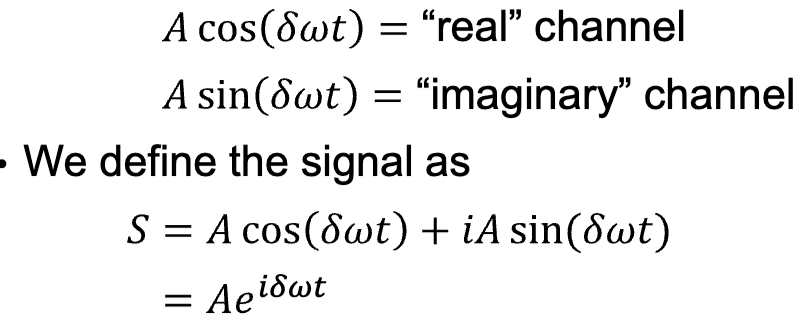
What is the audio-frequency low-pass filter chosen to have?
A cut off frequency greater than or equal to 1/2 F_total to sample all the signal frequencies while excluding higher frequency noise
Amount of noise relative to signal strength
SNR = signal / noise
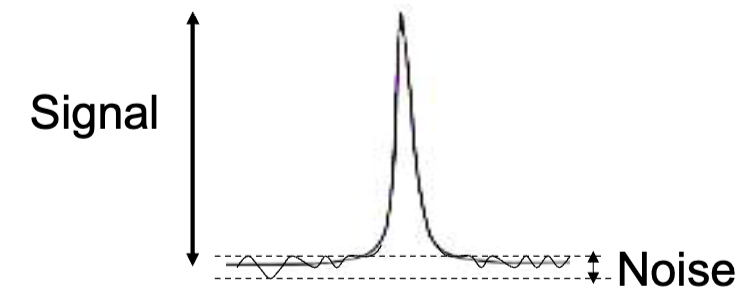
Noise increases slower than signal strength:

At least 5 x T1, which is a problem

Applied magnetic field and proton's local molecular environment
parts per million (ppm) relative to the ω of water
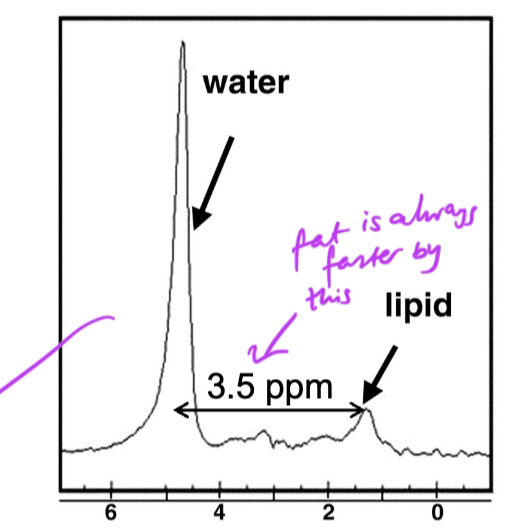
Difference in resonant frequency of water protons compared to fat protons
A technique to determine chemical composition via spectrum by acquiring data at different frequencies
Number of nuclei, isotopic abundance (proportion of atoms present that have non-zero spin)
nearly 100% natural abundance and high tissue concentration
Which nuclei are used as gas contrast agents in lung imaging?
Tips the net magnetization into the xy-plane due to a torque. (leads to no magneitzation in z plane
What does spin produce in an external field when at equilibrium?
Produces a net magnetisation M in the direction of B (z-direction)
What is the flip angle equation?
α = γ B_1 τ
τ = pulse duration
Why can't RF excitation be a single frequency sine wave (infinite)?
Magnetic field non-uniformity so spins will have varying resonant frequencies.
The RF pulse must have finite (specific) duration to achieve a 90 degree flip
What type of wave is the RF excitation?
Sinc wave as we want to excite a narrow range of frequencies centred on ω_0
sincx = sinx / x
What is the since function?
The sum of an infinite series of cosine waves of increasing frequency: oscillating pattern with lopes and shape is finite and encompasses range of frequencies
What happens after excitation?
The magnetisation relaxes back towards equilibrium by two processes: T1 (spin lattice longitudinal relaxation) and T2 (spin-spin transverse relaxation)
What is the T1 graph and equation?
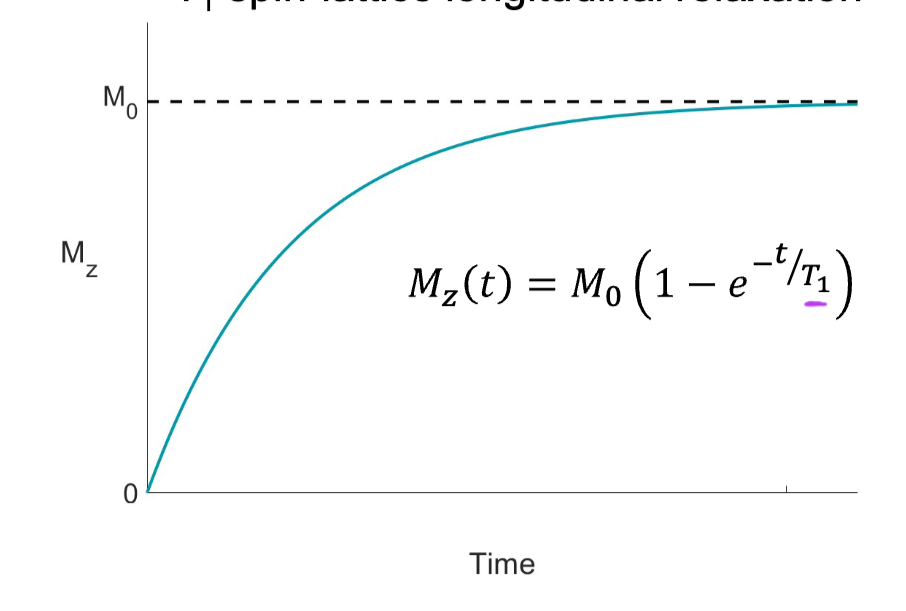
What is the T2 graph and equation?
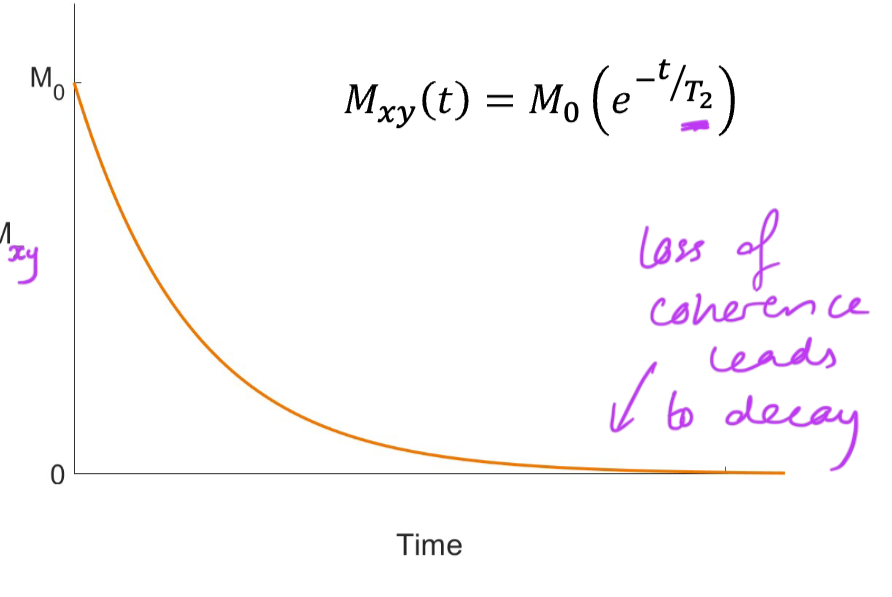
What does the free Induction decay look like and what does the signal produced look like?
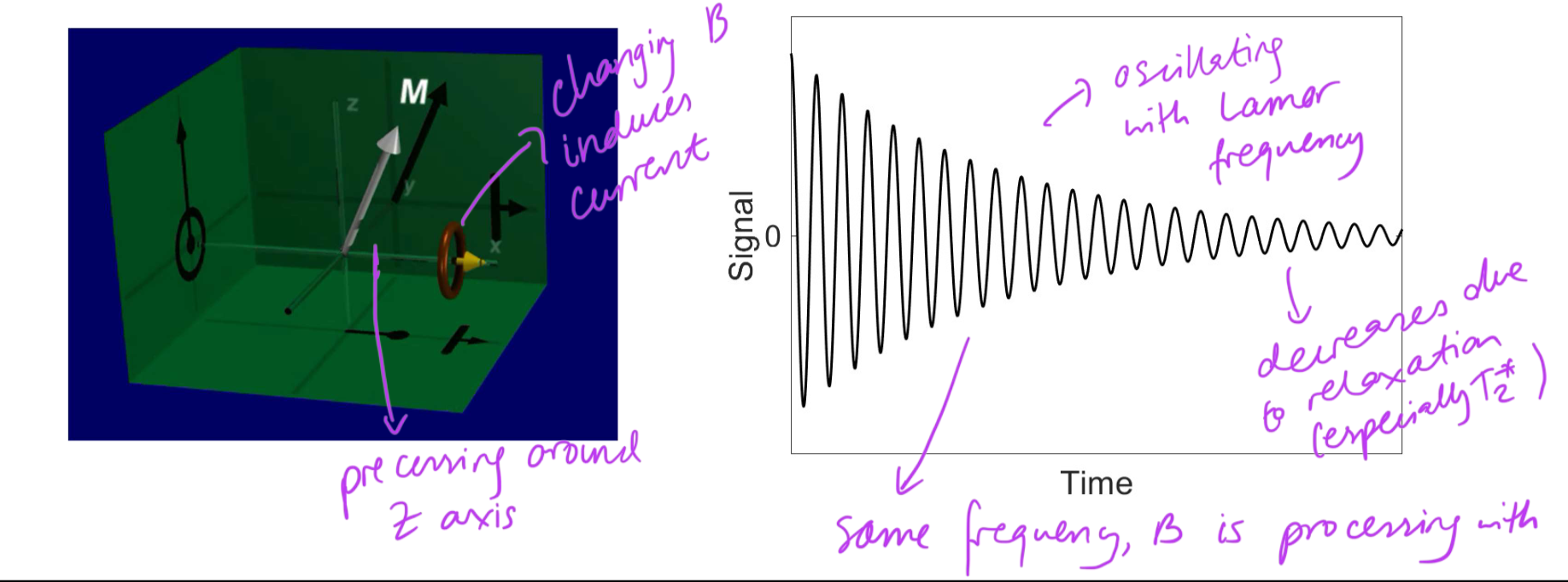
What is the FID signal picked up by?
An RF receiver coil and digitised
What is the Fourier Transform and Inverse Transform equations?
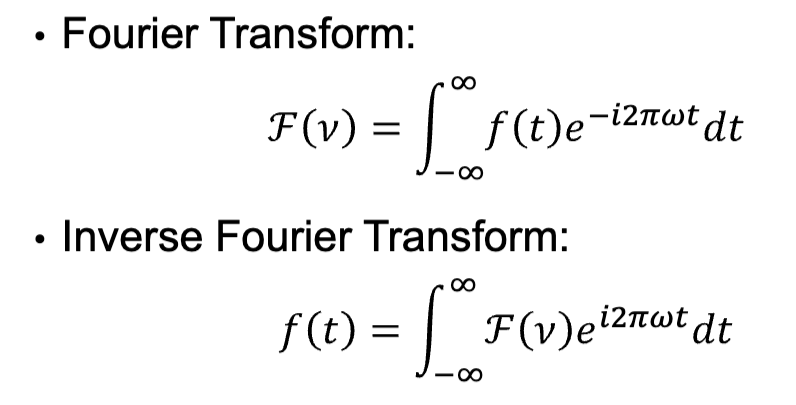
What does the spectrum look like when it goes from time to frequency?
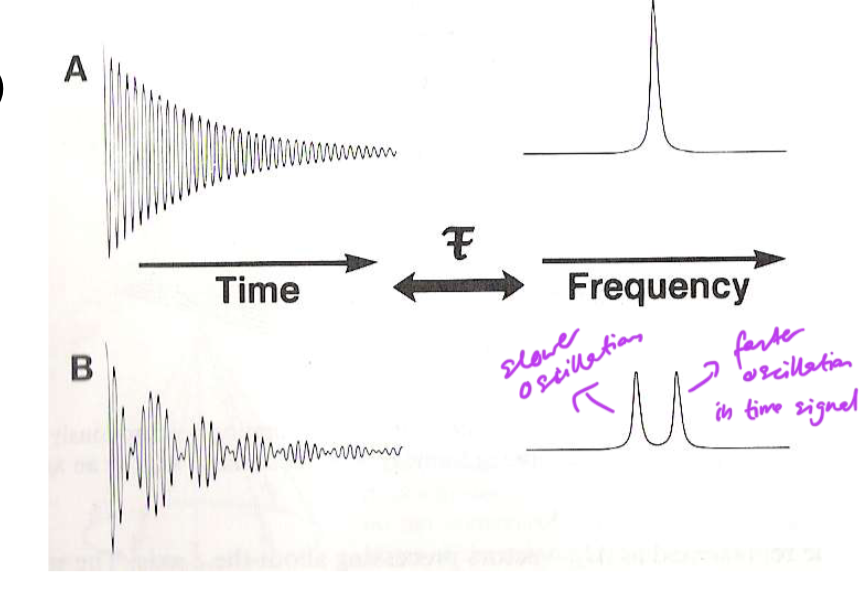
What is the Fourier transform of the FID?
It is a Lorentzian

What does the delta function for a single frequency look like?

What is the T*2 equation?
T*2 = 1/πΔv_1/2
where Δv_1/2 is the half-height linewidth of the resonance (wider the peak of Lorenzian, the more rapid the exponential decay)
What is the sinc function's Fourier transform?
The rectangular function (the truncated sinc function produces an almost rectangular FT)
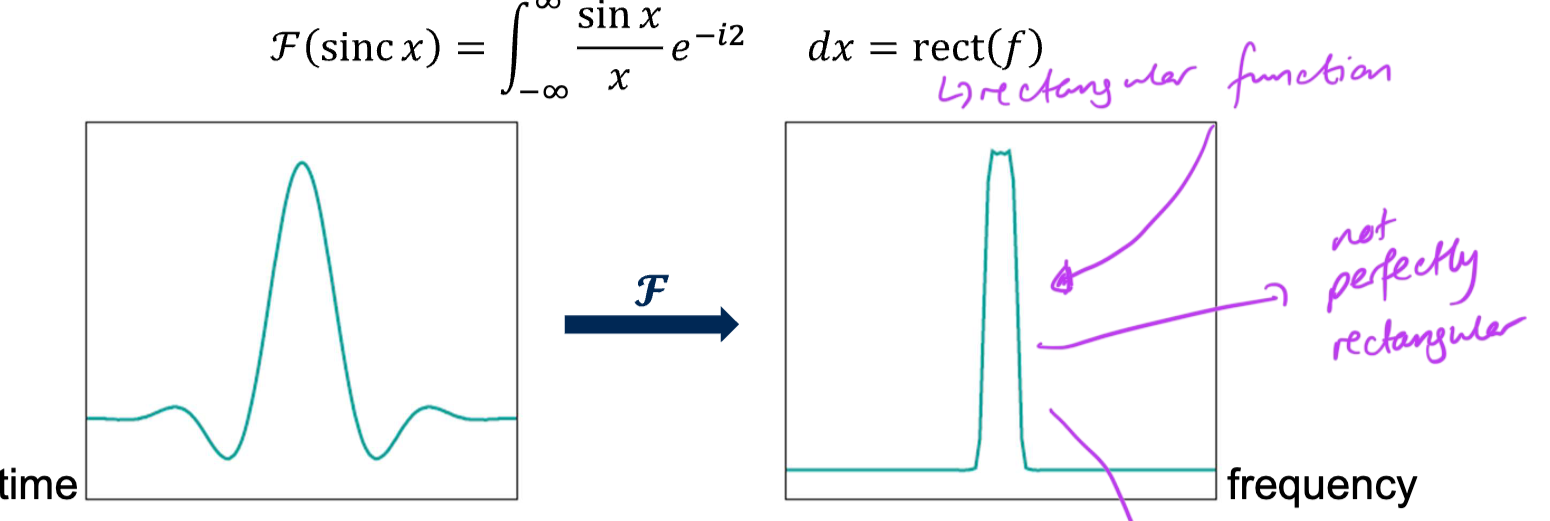
What is the equivalence in the frequency domain of choosing an appropriate time interval to avoid aliasing?
Choosing a spectral resolution Δv which will resolve all the frequencies that may be present in the FID
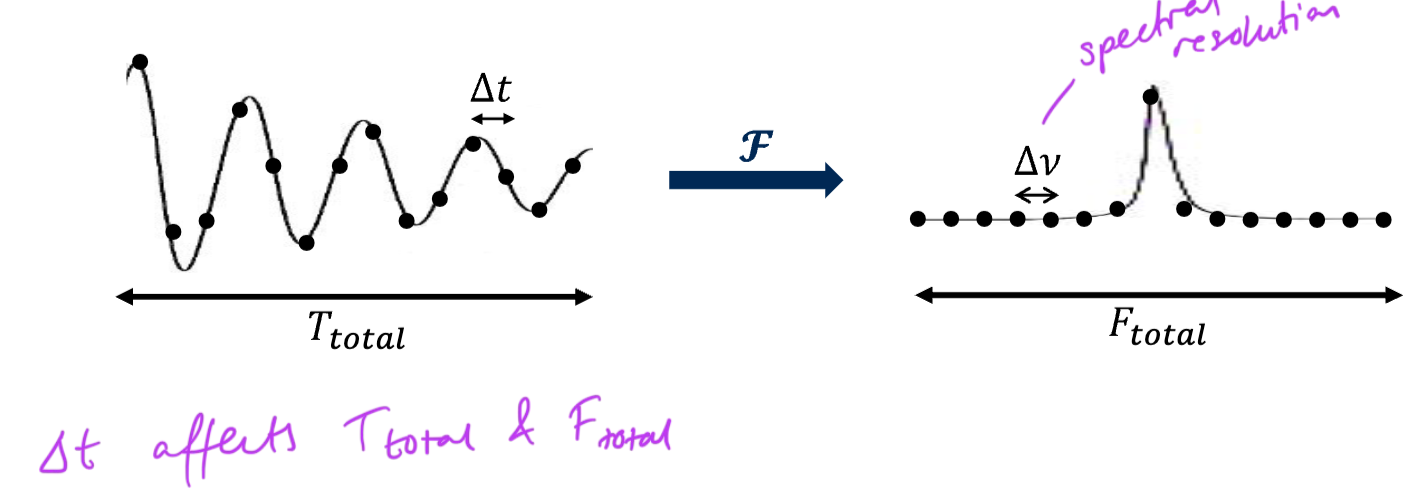
What does adequate and undersampling look like?
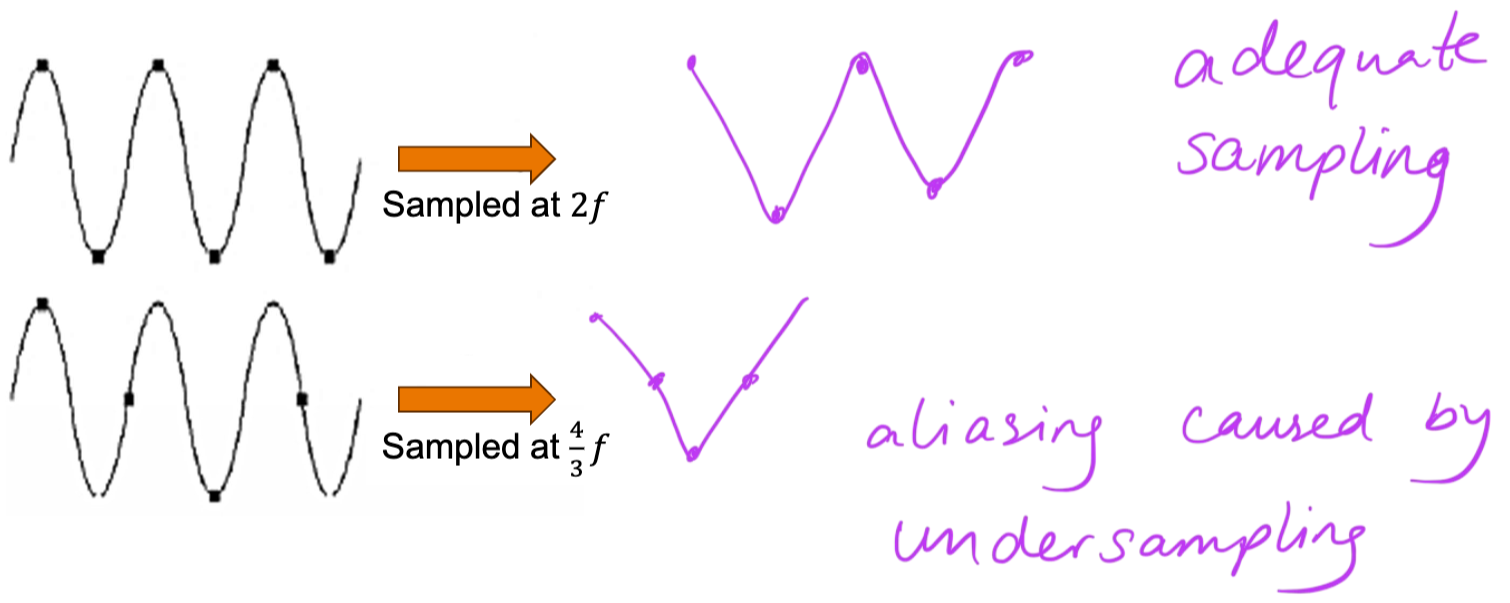
What needs to be done for two different frequencies to be resolved by a DFT?
One must have evolved at least an extra 2π (full oscillation) relative to the other by the end of T_total
Why won't the signal be oscillating at exactly the Lamor frequency?
Because of inhomogeneities and other factors
In demodulation (heterodyning) what is assumed about the frequency?
It oscillates at a slightly different frequency ω_0 + δω so the time course measured from ADC is A cos( ω_0t + δωt)
What is produced by solving the measured signal by reference signal demodulation equations?
Difference signal and sum is produced containing high frequency and low frequency components
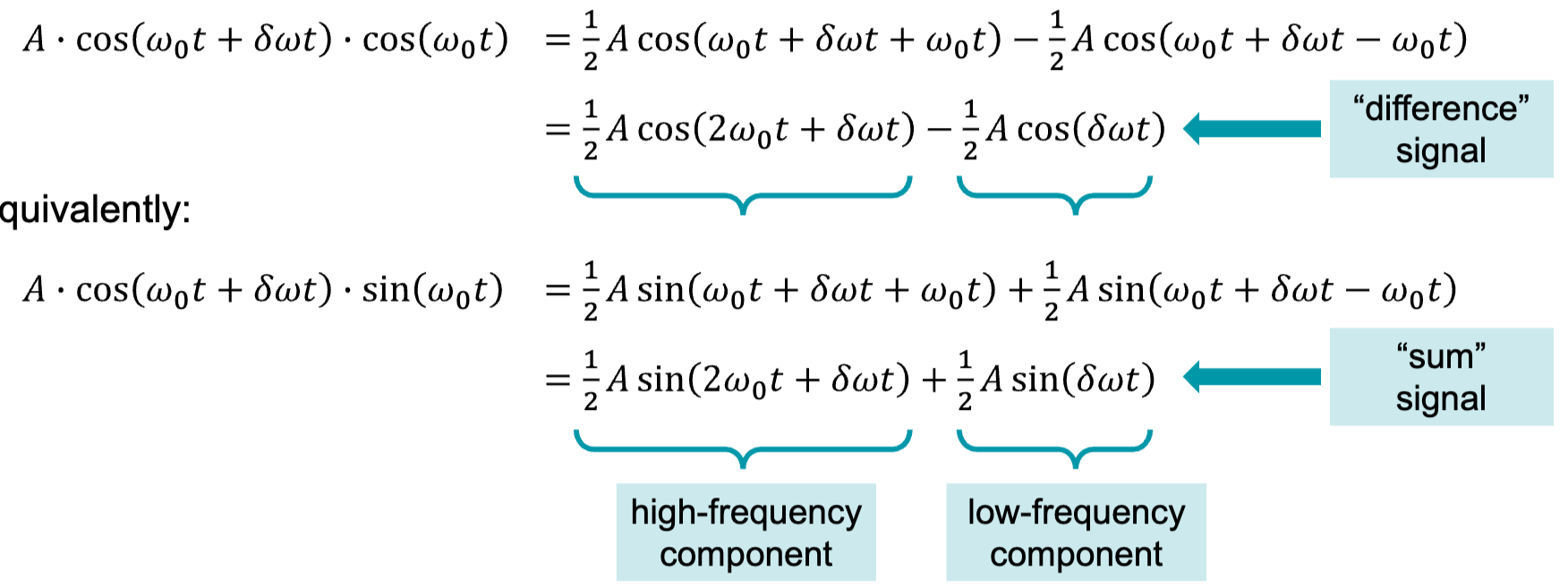
What is the process of demodulation (on a flow diagram)
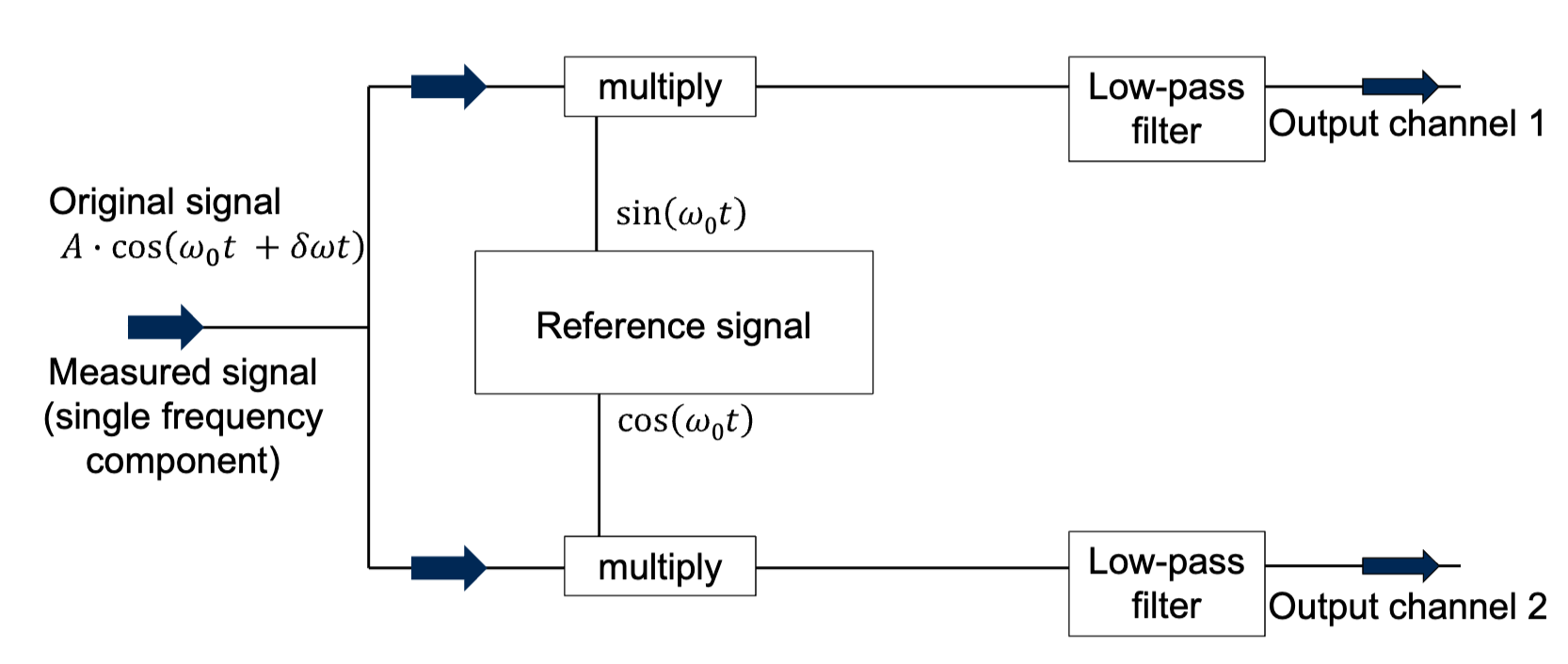
What do the low pass, high pass and notch band filters look like graphically?

What is known as demodulation?
Processing signals that have been filtered using audio-frequency electronics before storind them with an ADC
What does phase-sensitive detection allow?
Two output from one input (by mixing with sine and cosine respectively)

In addition to the NMR signal, what does the receiver coil pick up?
Random voltage fluctuations (noise)
What is noise generated by and what type of distribution does it have?
Generated by the thermal motion of ions within sample and within the receiver coil itself
Noise is random following a Gaussian distribution
What does noise depend on?
The effective electrical resistance of the sample and coil and their respective temperatures
If the same experiment is repeated multiple times what needs to happen each time? How can this be resolved?
Need to wait for M_z to recover fully each time so that we have the same amount of signal to begin with
By using a flip angle that is smaller than 90 degrees
What are nuclei surrounded by?
Electron clouds (appear as circulating currents) which generate small magnetic field which oppose B
What happens due to chemical shielding?
There is a different magnetic field: B = B_0 (1 - σ)
σ = shielding constant
What does the shielding constant σ increase with?
The local density of the electron cloud
What do hydrogen atoms in fat have?
Many more local electrons which leads to a larger degree of chemical shielding
What are chemical shift values invariant with respect to?
B_0
What does spin coupling cause?
Different peaks (electronic environment is different)
What does NMR spectroscopy identify?
The sample due to peaks in ppm graph: chemical shift of each peak identifies its composition
What does the NMR signal depend on?
Difference in populations between energy levels:
(bigger difference = bigger net signal measured)

What does cancer often have?
Unusual metabolic activity due to change in concentration of biological molecules
How is tumour located and its grade?
Compare spectrums to see Cho Cr and NAA peaks: difference in Larmor frequencies gives information
What is used to define the nuclear receptivity (NMR sensitivity)?
γ^3 C
C = natural abundance
This doesn't take into account, biological abundance of each nucleus
What is the receptivity of hydrogen?
1
What is hydrogen used for?
Measures lactate, choline, creatine and NAA in vivo (brain)


